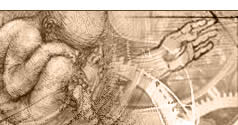 |
 |
 |
 |
 |
 |
 |
 |
|
 |
 |
 |
20 Cambrian explosion
|
| Menu | back |
In the Earths layers that predate the so-called Cambrian (which allegedly took place 488 to 542 million years ago), one finds only microfossils. In the Cambrian itself highly differentiated creatures suddenly appear. The assumption that single-cell and multi-cell organisms or plants and animals have common ancestors is not supported by the fossil record but rather massively challenged. This problem is generally acknowledged. Because the higher creatures appear explosively and without forerunners, the specialists talk about the Cambrian explosion.
The lowest Earth stratum to unequivocally contain fossils is referred to as the Cambrian. Cambrian explosion means the sudden appearance of many new blueprints, allegedly some 530 million years ago (1).
Eighty-seven percent of all phyla (plants and animals) appearing in the upper layers have also already occurred in the Cambrian. Only the vertebrates, the bryozoans and the insects first appear in the Earths upper layers (the Ordovician and/or Devonian). In the Earths strata older than the Cambrian, hardly a single undisputed higher fossil appears. There is, therefore, not a single piece of fossil evidence that the creatures that appear in the Cambrian explosion have common predecessors.
According to the theory of evolution, within the extremely short time of allegedly five to ten million years, at least nineteen to thirty-five new phyla (from a total of forty) appeared on the Earth for the first time (2) (3). Many new sub-phyla (thirty-two to forty-eight of a total of fifty-six) and classes of animals likewise appeared in these strata for the first time. All representatives of these phyla have important morphological traits. The morphological antecedents expected, according to the theory of evolution, in the earlier Vendian or in the Precambrian fauna are absent in almost every case (4).
More recent discoveries and analyses show that these morphological gaps are not accounted for simply by citing an incomplete fossil history (5). Because it is assumed that the fossil history is more or less reliable, scientists debate whether this observation concurs with the strictly monophyletic (a single comprehensive family tree) view of evolution (6).
Fast or slow fuses:
Those who believe fossils offer a reliable picture of the appearance of the so-called metazoans lean towards the view that these animals came into existence relatively quickly. Therefore, the Cambrian explosion had a so-called fast-fuse (7). Some (8), but not all (9), who think that the molecular phylogenies provide more reliable branching times of the Precambrian antecedents, believe that the Cambrian animals developed over a much longer time period and that the Cambrian explosion therefore had a slow fuse.
Ernst Mayr, the main advocate of the modern synthetic theory of evolution, who died in 2005, said when asked about the Cambrian explosion (10):
Almost all
phyla appear at the end of the Precambrian and the beginning of the Cambrian, that is, some 565 to 530 million years ago, in fully developed form. No fossils have been found which stand between them, and even today there are no such intermediary forms. The phyla appear, therefore, to be separated by unbridgeable gaps.
These 21 | Menu |
back
|
References:
|
| (1) |
Junker und Scherer, Evolution, ein kritisches Lehrbuch, Weyel, 2006, page 227. |
| (2) |
Ernst Meyer et al., DNA and the origin of life: information, specification and explanation, in J.A. Campbell und S.C. Meyer, Darwinism, Design and Public Education, Michigan State University Press, 2003, pages 223285, http://www.discovery.org/scripts/viewDB/index.php?command=view&id=2177. |
| (3) |
S.A. Bowring, J.P. Grotzinger, C.E. Isachsen, A.H. Knoll, S.M. Pelechaty und P. Kolosov, Calibrating rates of early Cambrian evolution, Science 261, 3. September 1993, pages 12931298. |
| (4) |
G.L.G. Miklos, Emergence of organizational complexities during metazoan evolution: perspectives from molecular biology, palaeontology and neo-Darwinism, Mem. Ass. Australas. Palaeontols 15, 1993, pages 741. |
| (5) |
M. Foote, Sampling, taxonomic description and our evolving knowledge of morphological diversity, Paleobiology 23, 1997, pages 181206. |
| (6) |
Simon Conway Morris, The question of metazoan monophyly and the fossil record, Progress in Molecular and Subcellular Biology 21, 1998, pages 19. |
| (7) |
Simon Conway Morris, Cambrian explosion of metazoans and molecular biology: would Darwin be satisfied?, International Journal of Developmental Biology 47, 2003, pages 505515. |
| (8) |
Gregory A. Wray, Jeffrey S. Levinton und Leo H. Shapiro, Molecular Evidence for Deep Precambrian Divergences Among Metazoan Phyla, Science 274, 25. Oktober 1996, pages 568573. |
| (9) |
Francisco José Ayala, Andrey Rzhetsky und Francisco J. Ayala, Origin of the metazoan phyla: molecular clocks confirm paleontological estimates, Proc Natl Acad Sci USA 95, 20. Januar 1998, pages 606611. |
| (10) |
Ernst Mayr, Das ist Evolution, 3. A., München, 2003, page 74. | |
Comment this Site!
|
 |
 |
 |
 |
|

